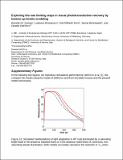Por favor, use este identificador para citar o enlazar a este item:
http://hdl.handle.net/10261/77302COMPARTIR / EXPORTAR:
 SHARE SHARE
 CORE
BASE CORE
BASE
|
|
| Visualizar otros formatos: MARC | Dublin Core | RDF | ORE | MODS | METS | DIDL | DATACITE | |

| Título: | Exploring the rate-limiting steps in visual phototransduction recovery by bottom-up kinetic modeling |
Autor: | Invergo, Brandon M. CSIC ORCID; Montanucci, Ludovica CSIC ORCID; Koch, Karl-Wilhelm; Bertranpetit, Jaume CSIC ORCID ; Dell’Orco, Daniele | Fecha de publicación: | 21-may-2013 | Editor: | BioMed Central | Citación: | Cell Communication and Signaling 11(1): 36 (2013) | Resumen: | [Background] Phototransduction in vertebrate photoreceptor cells represents a paradigm of signaling pathways mediated by G-protein-coupled receptors (GPCRs), which share common modules linking the initiation of the cascade to the final response of the cell. In this work, we focused on the recovery phase of the visual photoresponse, which is comprised of several interacting mechanisms. [Results] We employed current biochemical knowledge to investigate the response mechanisms of a comprehensive model of the visual phototransduction pathway. In particular, we have improved the model by implementing a more detailed representation of the recoverin (Rec)-mediated calcium feedback on rhodopsin kinase and including a dynamic arrestin (Arr) oligomerization mechanism. The model was successfully employed to investigate the rate limiting steps in the recovery of the rod photoreceptor cell after illumination. Simulation of experimental conditions in which the expression levels of rhodospin kinase (RK), of the regulator of the G-protein signaling (RGS), of Arr and of Rec were altered individually or in combination revealed severe kinetic constraints to the dynamics of the overall network. [Conclusions] Our simulations confirm that RGS-mediated effector shutdown is the rate-limiting step in the recovery of the photoreceptor and show that the dynamic formation and dissociation of Arr homodimers and homotetramers at different light intensities significantly affect the timing of rhodopsin shutdown. The transition of Arr from its oligomeric storage forms to its monomeric form serves to temper its availability in the functional state. Our results may explain the puzzling evidence that overexpressing RK does not influence the saturation time of rod cells at bright light stimuli. The approach presented here could be extended to the study of other GPCR signaling pathways. |
Versión del editor: | http://dx.doi.org/10.1186/1478-811X-11-36 | URI: | http://hdl.handle.net/10261/77302 | DOI: | 10.1186/1478-811X-11-36 | ISSN: | 1478-811X |
| Aparece en las colecciones: | (IBE) Artículos |
Ficheros en este ítem:
| Fichero | Descripción | Tamaño | Formato | |
|---|---|---|---|---|
| 1478-811X-11-36.xml | 132,45 kB | XML | Visualizar/Abrir | |
| 1478-811X-11-36-S1.PDF | 156,74 kB | Adobe PDF |  Visualizar/Abrir | |
| 1478-811X-11-36.pdf | 2,06 MB | Adobe PDF |  Visualizar/Abrir |
CORE Recommender
PubMed Central
Citations
11
checked on 17-abr-2024
SCOPUSTM
Citations
17
checked on 17-abr-2024
WEB OF SCIENCETM
Citations
17
checked on 24-feb-2024
Page view(s)
391
checked on 23-abr-2024
Download(s)
479
checked on 23-abr-2024

